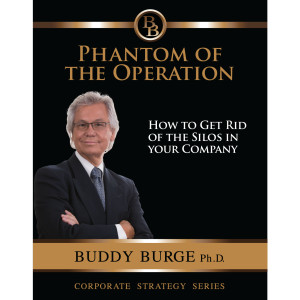
The following excerpt is taken from “The Phantom of the Operation”
Unnecessary Politics (Silos) are the Most Frustrating Part of any Organization
![CropperCapture[578]](http://buddyburge.com/wp-content/uploads/2014/04/CropperCapture578-300x218.png)
Silos are nothing more than the barriers that exist between departments within an organization, causing people who are supposed to be on the same team to work against one another.
And whether we call this phenomenon departmental politics, divisional rivalry, or turf warfare, it is one of the most frustrating aspects of life in any sizable organization.
Now, sometimes silos do come about because leaders at the top of an organization have interpersonal problems with one another.
But my experience suggests that this is often not the case.
Silos are not Caused by People
![CropperCapture[579]](http://buddyburge.com/wp-content/uploads/2014/04/CropperCapture579-300x214.png)
Surprisingly, interdepartmental politics, divisional rivalry and turf warfare for the most part are not caused by people.
They are primarily occasioned by the “silo system” utilized by most companies to run their operations.
In most situations, silos develop not because of what executives are doing purposefully but rather because of what they are failing to do.
They are not providing themselves and their employees with a compelling context for working together.
In other words, they fail to develop and institute the right system.
They and the system they have created tend to reward and measure and thereby unwittingly incentivize the very attitudes and behaviours the leader does not want in his company.
It is equally true that the very same “system” tends to enable and promote functional and departmental efficiency.
It even reduces costs and/or complexities through the global coordination and top-down orchestration of what is usually a set of complicated but predictable sequential activities.
But it also tends to fragment the organic, interdependent nature of the work process, thereby creating discord and dissonance among, with and between people and departments.
Departmental leaders and staff eventually begin to see the other departments and their personnel primarily as impediments to them doing their job.
It Goes Downhill from There
![CropperCapture[580]](http://buddyburge.com/wp-content/uploads/2014/04/CropperCapture580-266x300.png)
1) Over time, even the most well-meaning, intelligent people get distracted and frustrated.
2) Their frustration eventually disintegrates into resentment and then hostility.
3) Then, they begin to demonize their fellow workers who of course do exactly the same thing back to them.
4) And finally, a leader’s worst nightmare, people start working against their colleagues on purpose.
The Wrong, Indeed Lethal and Suicidal Leadership Interpretation
The leader, frustrated by the silo system and its attendant conflict, mistakenly attributes people’s pernicious behaviour to the immaturity and insecurity of employees who somehow just refuse to get along with one another.
This is the worst possible interpretation.
It dis-empowers the leader and debilitates the organization.
The problem isn’t your employees.
They can’t fix or overcome the true cause of the problem, the (silo) system.
Only the CEO can do that.
CEOs need to Provide Context
![CropperCapture[581]](http://buddyburge.com/wp-content/uploads/2014/04/CropperCapture581-206x300.png)
Without context, employees at all levels, especially executives, easily get lost, moving in different directions, often at cross-purposes.
Even the most well-meaning, intelligent people get distracted and confused amid the endless list of tactical and administrative details that come their way every day.
Pulled in many directions without a compass, they pursue seemingly worthwhile agendas under the assumption that their efforts will be in the best interest of the organization as a whole.
We are Blind to the Systems that we use Every day
![CropperCapture[582]](http://buddyburge.com/wp-content/uploads/2014/04/CropperCapture582-300x193.png)
Try asking a fish what “water” looks like, its composition and so forth.
And he is likely to respond with a furrowed and quizzical brow, “What is water?’
He can never really know until of course he is plucked from the ocean and is flopping around on a sun baked beach, gasping for water.
This by the way, is one of the most important reason to know and understand the three sport organizational model.
It helps leaders and employees know which system is at play in any given moment and thus as a matter of course, provides “context”.
But because we do not see or understand the systemic waters in which we find ourselves, employees get agitated as their colleagues in other divisions repeatedly move in different directions than them.
They begin to wonder why these other folks, the children of darkness so to speak, aren’t on board, in fact impede and sabotage their best efforts to simply do their jobs.
Over time, their confusion turns into disappointment, which eventually disintegrates into resentment, even hostility, toward their supposed teammates.
And then the worst thing possible happens.
They actually start working against those colleagues on purpose.
The Bad News – The Good News
![CropperCapture[583]](http://buddyburge.com/wp-content/uploads/2014/04/CropperCapture583-300x202.png)
So the bad news is that silos and divisiveness are caused by the CEO and/or his/her leadership team.
They have unwittingly created systems and unintentionally forged disparate agendas for different departments that gave rise to silos in the first place.
Every departmental silo in any company can ultimately be traced back to the leaders who have failed to understand the most important word in any organization, interdependence.
Interdependency exists intrinsically in and among the executive team.
Leaders often fail however to make those interdependencies clear to people or to leverage said interdependence in their own executive teams.
But if the bad news is that silos and divisiveness are caused by the CEO and/or his/her leadership team, then the good news is that you can also figure out how you can fix it.
Let me say it again, the blame for silos and politics belongs at the top of an organization and the CEO and her team are the only people who can put an end to it.
Thankfully, there is a simple and powerful way for those leaders to create a common sense of purpose, and a context for interdependency.
They must establish, for the executive team as well as the rest of the organization, a rallying cry.
They do this by launching a Macro Goal; a meaningful, large, overarching pursuit that captures the imagination of the entire organization.
And then systematically rally everyone to that common and overarching cause.
This is a rather systemic, high level and not unsophisticated analysis to and for the schisms and discord that bedevil and afflict far too many organizations.
For further explication, I recommend you read “The Phantom of the Operation: How to get rid of Silos in your Company” in its’ entirety.
I think as a leader, you will find it to be quite useful, practical, therapeutic and a strategically sound treatment on the issue of conflict between and among people and departments in your company.
For more on this topic, we recommend the following | |
 | Phantom of the OperationHow to Get Rid of the Silos in your Company Click Here For Video and Full Description If you found this article useful |

